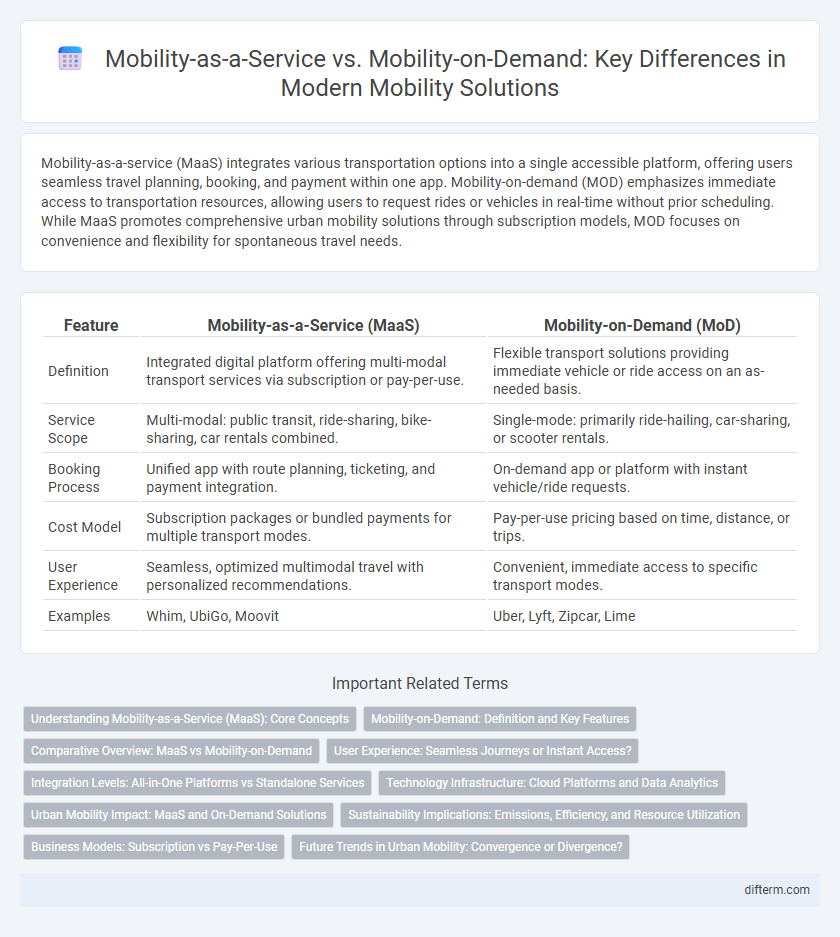Mobility-as-a-service (MaaS) integrates various transportation options into a single accessible platform, offering users seamless travel planning, booking, and payment within one app. Mobility-on-demand (MOD) emphasizes immediate access to transportation resources, allowing users to request rides or vehicles in real-time without prior scheduling. While MaaS promotes comprehensive urban mobility solutions through subscription models, MOD focuses on convenience and flexibility for spontaneous travel needs.
Table of Comparison
| Feature | Mobility-as-a-Service (MaaS) | Mobility-on-Demand (MoD) |
|---|---|---|
| Definition | Integrated digital platform offering multi-modal transport services via subscription or pay-per-use. | Flexible transport solutions providing immediate vehicle or ride access on an as-needed basis. |
| Service Scope | Multi-modal: public transit, ride-sharing, bike-sharing, car rentals combined. | Single-mode: primarily ride-hailing, car-sharing, or scooter rentals. |
| Booking Process | Unified app with route planning, ticketing, and payment integration. | On-demand app or platform with instant vehicle/ride requests. |
| Cost Model | Subscription packages or bundled payments for multiple transport modes. | Pay-per-use pricing based on time, distance, or trips. |
| User Experience | Seamless, optimized multimodal travel with personalized recommendations. | Convenient, immediate access to specific transport modes. |
| Examples | Whim, UbiGo, Moovit | Uber, Lyft, Zipcar, Lime |
Understanding Mobility-as-a-Service (MaaS): Core Concepts
Mobility-as-a-Service (MaaS) integrates multiple transport modes into a single accessible platform, enabling seamless trip planning, booking, and payment through one interface. This approach prioritizes user-centric services by aggregating public transit, ride-sharing, bike rentals, and more, enhancing convenience and reducing reliance on private vehicles. Core concepts include interoperability, real-time data integration, and personalized mobility options that optimize urban transport efficiency and sustainability.
Mobility-on-Demand: Definition and Key Features
Mobility-on-Demand (MoD) refers to transportation services that allow users to request and access vehicles in real-time, typically through mobile apps, without the need for ownership. Key features include flexible routing, dynamic pricing, and integration with various transport modes like ride-hailing, bike-sharing, and car rentals. This model enhances urban mobility by reducing wait times, increasing vehicle utilization, and promoting sustainable transport options.
Comparative Overview: MaaS vs Mobility-on-Demand
Mobility-as-a-Service (MaaS) integrates various transportation modes into a single digital platform, offering users seamless trip planning, booking, and payment services. Mobility-on-Demand (MoD) emphasizes real-time, user-requested transit options like ride-hailing, bike-sharing, and microtransit, focusing on flexibility and immediate access. While MaaS prioritizes a holistic, subscription-based approach to urban mobility, MoD centers on dynamic, on-demand transportation solutions tailored to individual trip needs.
User Experience: Seamless Journeys or Instant Access?
Mobility-as-a-Service (MaaS) prioritizes seamless journeys by integrating multiple transportation modes into a unified platform, enhancing route planning, payment, and real-time updates for users. Mobility-on-Demand (MoD) emphasizes instant access, providing immediate ride requests and dynamic vehicle availability to meet urgent travel needs. Optimizing user experience involves balancing MaaS's comprehensive trip coordination with MoD's rapid responsiveness, creating a flexible and efficient travel ecosystem.
Integration Levels: All-in-One Platforms vs Standalone Services
Mobility-as-a-Service (MaaS) offers seamless integration by combining multiple transportation modes into all-in-one platforms, enabling users to plan, book, and pay through a single interface. In contrast, Mobility-on-Demand (MoD) typically operates as standalone services, providing flexible and immediate access to individual transport options like ride-hailing or bike-sharing without cross-modal integration. The integration level of MaaS enhances user convenience and system efficiency, while MoD prioritizes rapid accessibility and service specificity.
Technology Infrastructure: Cloud Platforms and Data Analytics
Mobility-as-a-Service (MaaS) relies heavily on cloud platforms to integrate various transportation modes into a seamless user experience, enabling real-time data processing and dynamic route optimization. Mobility-on-Demand (MoD) leverages data analytics to predict user demand patterns and allocate vehicles efficiently, improving responsiveness and reducing wait times. Advanced cloud infrastructure supports both models by providing scalable storage and computing power essential for managing large datasets and delivering personalized mobility solutions.
Urban Mobility Impact: MaaS and On-Demand Solutions
Mobility-as-a-Service (MaaS) integrates various urban transport modes into a unified digital platform, enhancing accessibility and reducing reliance on private vehicles. Mobility-on-demand solutions, such as ride-hailing and e-scooters, offer flexible, real-time transport options that address last-mile connectivity and decrease congestion. Together, these innovations significantly optimize urban mobility by promoting shared resources, lowering emissions, and improving traffic flow efficiency.
Sustainability Implications: Emissions, Efficiency, and Resource Utilization
Mobility-as-a-Service (MaaS) integrates multiple transportation modes to optimize route efficiency and significantly reduce carbon emissions through shared vehicle use and coordinated travel planning. In contrast, Mobility-on-Demand (MoD) offers flexible, instant transportation options that can lead to increased vehicle miles traveled and higher emissions if not managed with sustainable fleet strategies. MaaS platforms enhance resource utilization by promoting multi-modal connections and reducing reliance on private car ownership, whereas MoD requires careful implementation of electric or hybrid fleets to minimize environmental impact.
Business Models: Subscription vs Pay-Per-Use
Mobility-as-a-Service (MaaS) primarily employs a subscription-based business model, offering users unlimited or bundled access to various transport modes for a fixed monthly fee, enhancing convenience and cost predictability. In contrast, Mobility-on-Demand (MoD) leverages a pay-per-use model, enabling users to access specific transport services like ride-hailing or bike-sharing only when needed, optimizing flexibility and reduces idle costs. The choice between subscription and pay-per-use models impacts customer acquisition strategies, revenue stability, and service scalability within the urban mobility ecosystem.
Future Trends in Urban Mobility: Convergence or Divergence?
Future trends in urban mobility reveal a complex interplay between Mobility-as-a-Service (MaaS) and Mobility-on-Demand (MoD) models, where MaaS integrates multiple transportation modes into seamless digital platforms, while MoD emphasizes real-time access to individual transport options. Advances in AI, data analytics, and 5G connectivity are driving convergence by enabling personalized, flexible, and efficient urban travel experiences that blend subscription-based services with on-demand access. However, the divergence persists as MaaS platforms aim for long-term multimodal integration, contrasting with MoD's focus on immediate, user-centric vehicle availability, highlighting ongoing evolution toward hybrid mobility ecosystems.
mobility-as-a-service vs mobility-on-demand Infographic

 difterm.com
difterm.com